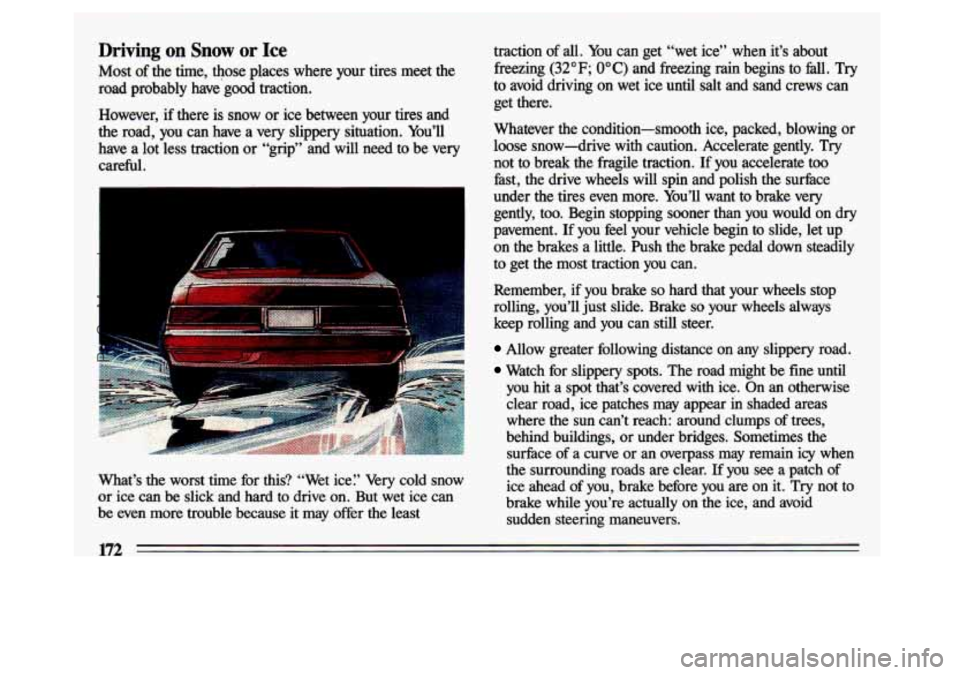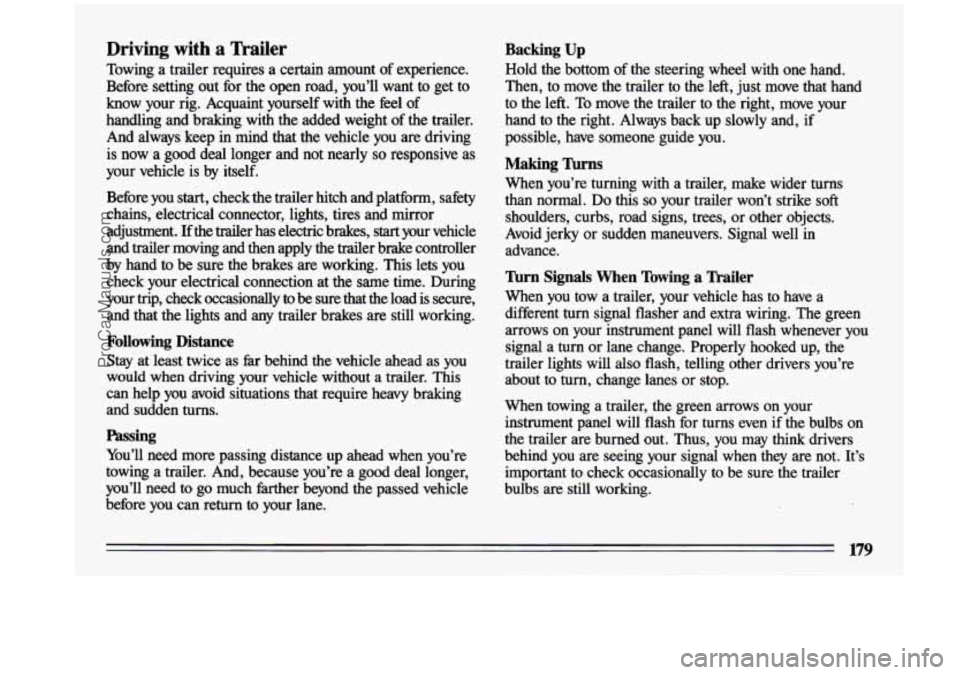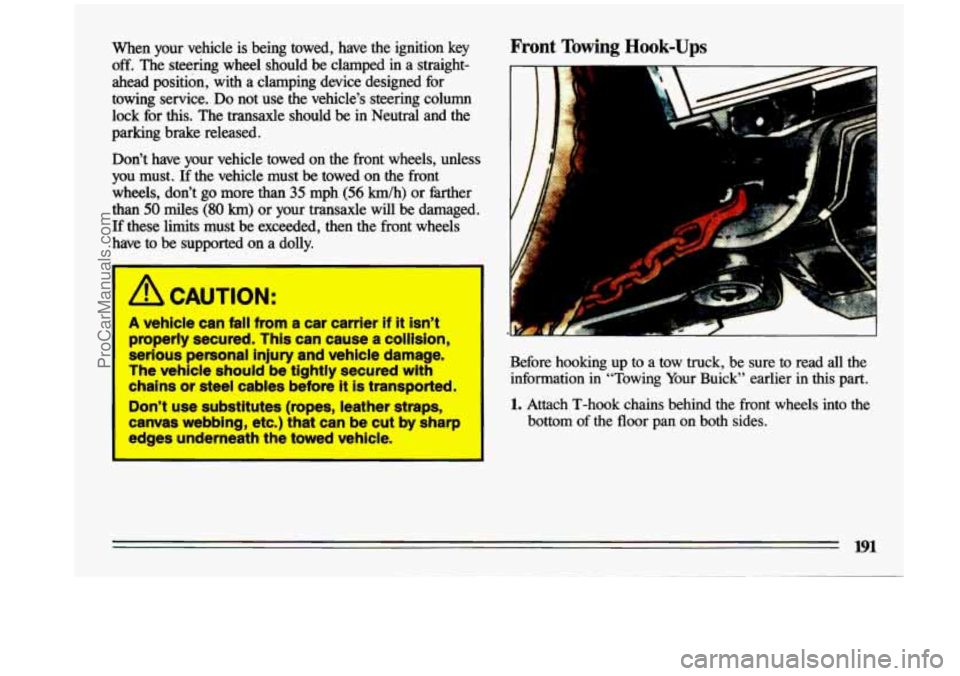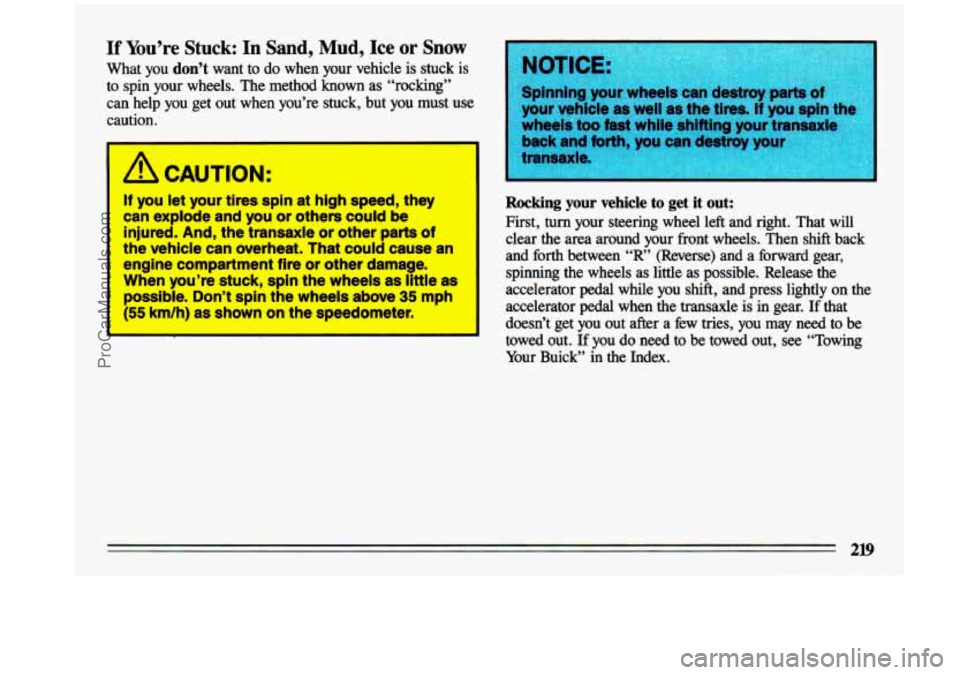1993 BUICK CENTURY steering
[x] Cancel search: steeringPage 157 of 324

In a braking skid (where the wheels are no longer
rolling), release enough pressure on the brakes to get the
wheels rolling again.
This restores steering control. Push
the brake
pedal down steadily when you have to stop
suddenly.
As long as the wheels are rolling, you will have
steering control. Steer the way you want to go.
Driving at Night
Night driving is more dangerous than day driving. One
reason is that some drivers are likely to be impaired-by
alcohol or drugs, with night vision problems, or by fatigue.
Here are some tips on night driving.
Drive defensively. Remember, this is the most
dangerous time.
Don’t drink and drive. (See “Drunken Driving” in the
Index for more on this problem.)
Adjust your inside rearview mirror to reduce the glare
from headlights behind you.
Since you can’t see as well, you may need to slow
down and keep more space between you and other
vehicles. It’s hard to tell how fast the vehicle ahead is
going just by looking at its taillights.
Slow down, especially on higher speed roads. Your
headlights can light up only
so much road ahead.
In remote areas, watch for animals.
If you’re tired, pull off the road in a safe place and rest.
ProCarManuals.com
Page 174 of 324

Driving on Snow or Ice
Most of the time, those places where your tires meet the
road probably have’good traction.
However, if there is
snow or ice between your tires and
the road, you can have a
very slippery situation. You’ll
have a lot less traction or “grip” and will need to be very
careful.
r
-
I
.. .
What’s the worst time for this? “Wet ice? Very cold snow
or ice can be slick and hard to drive on. But
wet ice can
be even more trouble because it may offer the least traction
of all. You can get “wet ice” when it’s about
freezing
(32°F; OOC) and freezing rain begins to fall. Try
to avoid driving on
wet ice until salt and sand crews can
get there.
Whatever the condition-smooth ice, packed, blowing or
loose snow-drive with caution. Accelerate gently. Try
not to break the fragile traction. If you acceierate too hst, the drive wheels will spin and polish the surface
under the tires even more. You’ll want to brake very
gently, too. Begin stopping sooner than you would on dry
pavement. If you feel your vehicle begin to slide, let up
on the brakes a little. fish the brake pedal down steadily
to get the most traction you can.
Remember, if you brake
so hard that your wheels stop
rolling, you’ll just slide. Brake
so your wheels always
keep rolling and you can still steer.
Allow greater following distance on any slippery road.
Watch for slippery spots. The road might be fine until
you hit a spot that’s covered with ice. On an otherwise
clear road, ice patches may appear
in shaded areas
where the sun can’t reach: around clumps of trees,
behind buildings, or under bridges. Sometimes the
surfixe of a curve or an overpass may remain icy when
the surrounding roads are clear. If you see a patch
of
ice ahead of you, brake before you are on it. Try not to
brake while you’re actually
on the ice, and avoid
sudden steering maneuvers.
ProCarManuals.com
Page 181 of 324

Driving with a Trailer
Towing a trailer requires a certain amount of experience.
Before setting out for the open road, you’ll want to get t\
o
know your rig. Acquaint yourself with the
feel of
handling and braking with the added weight of the trailer.
And always keep in mind that the vehicle you
are driving
is now a good deal longer and not nearly
so responsive as
your vehicle is by itself.
Before you
start, check the trailer hitch and platform, safety
chains, electrical connector, lights, tires and mirror
adjustment. If the trailer has electric brakes,
start your vehicle
and trailer moving and then apply the trailer brake controller \
by hand to be sure the brakes
are working. This lets you
check your electrical connection at the same time. During
your trip, check occasionally
to be sure that the load is secure,
and that the lights and any trailer brakes are still working.
Following Distance
Stay at least twice as fit, behind the vehicle ahead as you
would when driving your vehicle without a trailer. This
can help you avoid situations that require heavy braking
and sudden turns.
Passing
You’ll need more passing distance up ahead when you’re
towing
a trailer. And, because you’re a good deal longer,
you’ll
need to go much farther beyond the passed vehicle
before you can return to your lane.
Backing Up
Hold the bottom of the steering wheel with one hand.
Then, to move the trailer to the left, just move that hand
to the left.
To move the trailer to the right, move your
hand to the right. Always back up slowly and, if
possible, have someone guide you.
Making nrns
When you’re turning with a trailer, make wider turns
than normal.
Do this so your trailer won’t strike soft
shoulders, curbs, road signs, trees, or other objects.
Avoid jerky or sudden maneuvers. Signal well in
advance.
Turn Signals When Towing a Mler
When you tow a trailer, your vehicle has to have a
different turn signal flasher and extra wiring. The green arrows on your instrument panel will flash whenever you
signal a turn or lane change. Properly hooked up, the
trailer lights will also flash, telling other drivers you’re \
about to turn, change lanes or stop.
When towing a trailer, the green arrows on your instrument panel will flash for turns even if the bulbs on
the trailer are burned out. Thus, you may think drivers
behind you are seeing your signal when they are not. It’s
important to check occasionally to be sure the trailer
bulbs are still working.
179
ProCarManuals.com
Page 193 of 324

when your vehicle is being towed, have the ignition key Front Towing Hook-Ups
off. The steering wheel should be clamped in a straight-
ahead position, with a clamping device designed for
towing service.
Do not use the vehicle’s steering column
lock for
this. The transaxle should be in Neutral and the
parking brake released.
I
Don’t have your vehicle towed on the front wheels, unless
you must. If the vehicle must be towed on the front
wheels, don’t go more than
35 mph (56 km/h) or farther
than
50 miles (80 km) or your transaxle will be damaged.
If these limits must be exceeded, then the front wheels
have
to be supported on a dolly.
1
I
&!, CAUTION:
A vehicle can fall from a car carrier if It Isn’t
properly secured.
This can cause a colllsion,
serious personal injury and vehicle damage.
The vehicle should be tightly secured with Before hooking up to a tow truck, be sure to read all the
chains or steel cables before it is transported. information in “Towing Your Buick” earlier in this part.
Don’t use substitutes (ropes, leather straps, I
1. Attach T-hook chains behind the front wheels into the
canvas webbing, etc.) that can be cut by sharp bottom of the floor pan on both sides.
edges underneath the towed vehicle. I
191
ProCarManuals.com
Page 207 of 324

8. Then replace the pressure cap. Be sure
the
arrows on the pressure
cap line up like this.
If a Tire Goes Flat
It’s unusual for a tire to “blow out” while you’re driving,
especially if you maintain your tires properly. If air
goes
out of a tire, it’s much more likely to leak out slowly. But
if you should ever have a “blowout:’ here are a few tips
about what to expect and what to do:
If a front tire fails, the flat tire will create a drag that
pulls
the vehicle toward that side. Take your foot off the
accelerator pedal and grip
the steering wheel firmly.
Steer to maintain lane position, then gently brake to a
stop well out of the traffic lane.
A rear blowout, particularly on a curve, acts much like a
skid and may require the same correction you’d use in a skid.
In any rear blowout, remove your foot from the
accelerator pedal. Get the vehicle under control by
steering the way you want the vehicle
to go. It may be
very bumpy and noisy, but you can still steer. Gently brake
to a stop, well off the road if possible.
If your tire goes flat; the next section shows how to use
your jacking equipment to change a flat tire safely.
Changing a Flat Tire
If a tire goes flat, avoid further tire and wheel damage ~y
driving slowly to a level place. Turn on your hazard
warning flashers.
A CAUTION:
Changing a tire can cause an injury. The vehicle can slip
off the jack and roll over you
or other people. You and they could be badly injured. Find a level place to change your tire.
To help prevent the vehicle from moving:
1. Set the parking brake firmly.
2. Put the shift lever in “P” (Park).
3. Turn off the engine.
CAUTION (Continued)
205
ProCarManuals.com
Page 221 of 324

If You’re Stuck: In Sand, Mud, Ice or Snow
What you don’t want to do when your vehicle is stuck is
to spin your wheels. The method known as “rocking”
can help you get out when you’re stuck, but
you must use
caution.
wneels can destr
If you let your tires spln at high spe& they
can aplode and you or others could be
Injured. And, the,transaxle or other parts of
the vehicle can &wheat. That could muse an
engine compartment fire or other damage.
When you’re stuck, spin the wheels 88 lltek adc
-pssSble. Don’t spln the whwls above 35 mph
(55 Wh) as shown on the speedometer.
Rocking your vehicle to get it out:
First, turn your steering wheel left and right. That will
clear the area around your fiont wheels. Then
shift back
and forth between
“R” (Reverse) and a forward gear,
spinning the wheels as little as possible. Release the
accelerator
pedal while you shift, and press lightly on the
accelerator
pedal when the transaxle is in gear. If that
doesn’t get you out after a few tries, you may need to be
towed out.
If you do need to be towed out, see “Towing
Your Buick”
in the Index.
ProCarManuals.com
Page 223 of 324

.
n
Part 6 Service and Appearance Care
. .
Here you will find information about the care of your Buick . This part begins with service and fuel information.
and then
it shows how to check important fluid and lubricant levels . There is also technical information about
your vehicle. and a section devoted to
its appearance care .
Part 6 includes:
Service ........................................................................\
..... 222
Fuel ........................................................................\
...... 223
HoodRelease ....................................................................... \
226
Engine Oil ........................................................................\
. 227
Aircleaner ........................................................................\
2.3
TransaxleFluid ..................................................................... 236
Enginecoolant ..................................................................... 239
Power Steering Fluid ................................................................. 241
Windshield Washer Fluid .............................................................. 242
Brakes ........................................................................\
.... 243
Battery ........................................................................\
.... 244
BulbReplacement ................................................................... 245
Tires ........................................................................\
...... 251
Loadingyourvehicle ................................................................. 249
Appearancecare .................................................................... 258
Vehicle Identification Number (VIN), Add-on Electrical Equipment ............................ 265
Capacities and Specifications .......................................................... -270
Fuses&CircuitBreakers .............................................................. 266
ReplacementBulbs .................................................................... 269
ProCarManuals.com
Page 243 of 324

Radiator Pressure Cap
ur radiator cap is a 15 psi (105 kPa)
When you replace your radiator pressure cap, an AC@
cap is recommended.
Thermostat
Engine coolant temperature is controlled by a thermostat
in the engine coolant system. The thermostat stops the
flow of coolant through the radiator until the coolant
reaches a preset temperature.
When you replace
your thermostat, an AC@ thermostat is
recommended.
Power Steering Fluid
mp ”-- How to Check Power
Steering Fluid:
I Unscrew the cap and wipe
the dipstick with a clean f rag. Replace the cap and
completely tighten it. Then
remove the cap again and
look at the fluid level on the
dipstick. .1,. ,,
When me engine compartment is hot, the level should
When the engine compartment is cool, the level should
be at the “H” (Hot) mark.
be at the “C” (Cold) mark.
What to Add:
Refer to the Maintenance Schedule to determine what
kind
of fluid to use. See “Recommended Fluids and
Lubricants” in the Index.
241
ProCarManuals.com